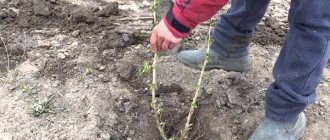Traditionally a southern crop, grapes are today grown even in the cold regions of Siberia and North-West Russia. In order to harvest, gardeners have to delve into all the intricacies of growing berries: fertilizing, replanting, pruning, wintering. Typically, grapes are transplanted to a new location in the fall, when the plant goes into hibernation. Having correctly performed all the agricultural techniques, after a couple of years, ripe, tasty berries are collected from the bushes.
General information about transplanting grapes
Why replant grapes? The reasons are different:
- incorrectly chosen place for cultivation in the garden;
- redevelopment of the site;
- construction of an outbuilding;
- inconvenient neighborhood (bushes or trees grow nearby that interfere with the grapes);
- the specifics of the variety were not taken into account during the first planting (the bushes have grown large, the feeding area for planting is not enough).
When planning the procedure, take into account agricultural technology and cultural characteristics. It is advisable to transplant the grapes to another place in the fall, while the bushes are no more than 5-6 years old. Because they adapt faster to new conditions. The best time is spring or autumn, the period when the grapes “sleep” and are at rest.
A new area for planting is prepared in advance by adding the necessary fertilizers and cultivating the soil. Before transplanting adult grapes, you will need to trim the above-ground part, so the plants will more easily withstand stress and take root better. After adaptation, the inflorescences are removed from the bushes of the transplanted vineyard, not allowing them to bear fruit for a couple of years. The bushes will gain strength, become stronger, and after 2-3 years fruiting is allowed.
Why is transplantation done in the fall?
According to the rules of agricultural technology, the crop is replanted in early spring or autumn. Experienced winegrowers believe that it is better to replant grape bushes in the fall, so they take root faster and get sick less. Be sure to take into account the weather and climate of the area.
What are the advantages of transplanting grapes in the fall:
- the plant goes into a period of “rest”;
- autumn rains will ensure regular watering of the bushes;
- After summer, the soil remains warm, so the root system does not experience severe stress.
The transition to sleep in grapes is gradual. The first part, after the leaves fall, is the above-ground part, while the roots are still very active. Thanks to this, the bush has time to take root in a new place before the onset of cold weather.
On a note! The optimal time for replanting is 15-18 days after the leaves fall from the bushes.
The timing of transplanting different grape varieties varies and depends on the region:
- in the southern regions - in late October or early November;
- in the regions of the middle zone, in the Moscow region - from mid-October;
- in the North-West, in the Urals - early October.
The weather forecast for the current season and terrain features are taken into account. The main thing is that the transplanted bushes are not exposed to early frosts.
Preparatory work
We recommend reading our other articles
- Cucumber variety Far Eastern 27
- Zucchini variety Roller
- Pavlovsk lemon - growing features and care
- How to store winter garlic
Before transplanting grapes, it is worth carrying out preparatory work. The place for planting grapes is always chosen to be sunny, so that the light falls on the bush and warms it up well. At the same time, the place must be protected from wind and drafts on at least one side. If there are other bushes and trees on the site, they should be at a distance of 2-4 meters from the grapes.
The planting hole is made at least 1 month before planting the bush
Important!
The grapes have a developed root system. A site for it is chosen with a low groundwater level (at least 2 meters), otherwise the roots of an adult bush may begin to rot.
The planting hole is made at least 1 month before planting the bush. It is dug a meter deep and 60-80 cm wide, depending on the size of the seedling. Drainage is placed at the bottom if the soil is dense, heavy and does not allow water to pass through well. You can use broken brick, expanded clay or pebbles as drainage. Planting soil is mixed from soil obtained by digging a hole, humus, wood ash, superphosphate and potassium sulfate. The components are mixed and left for a month.
You should purchase a seedling from a specialized store or grow it yourself from a cutting. A young bush should have a developed root system, a growth of 35 cm. Before planting, 1-2 buds are cut off from the bush. The cuts are lubricated with garden varnish so that the bush does not start to hurt. Bare roots are shortened to 30 cm, diseased and damaged ones are simply cut off. You can soak the root system in a growth stimulator for 12-24 hours, then it will take root faster in a new place.
Threats to grapes during transplantation
When planning to replant grapes, do not forget to provide the plants with complete and proper care. Without following the rules, there are many risks of losing the bushes, losing the variety and losing the harvest.
Threats:
- within a couple of years you will have to stop picking berries from the transplanted vines;
- berries of a certain variety often change their taste;
- transplanted plants are more often susceptible to infections (the insidious phylloxera is especially dangerous).
It is not allowed to place a bush in place of harvested plants, as this leads to diseases of the crop. There is a high risk of losing a plant when transplanting grapes over 7-8 years of age, but with care and proper care, such specimens will survive.
Varieties of grapes, specifics of transplantation
In the middle zone and in the northern regions several varieties of grapes are grown:
- dining room (for picking berries);
- maiden;
- wild (for landscaping).
The last two species are unpretentious, do not require special care and grow in any cultural conditions. Lianas instantly grow, wrapping around supports; it is no coincidence that they are so popular in landscape design. They easily tolerate transplantation, quickly take root in a new place and grow wildly.
Wine and table grape varieties will require special care, including during replanting. Violation of agricultural technology often leads to the death of valuable crop varieties.
Work in the fall: we are confirming the dates
It is difficult to indicate exact dates for grapes, since various factors are taken into account:
- variety;
- condition of the bushes;
- age of the vines;
- climatic conditions of the area;
- weather.
One of the main conditions is the complete fall of the leaves, indicating that the plant is approaching a state of “dormancy”, but the root system is still strong.
In what month
Leaf fall from bushes on grape plantations begins in September-October. The soil is warm at this time, the roots are fully functioning. This is a suitable time for replanting, but taking into account long-term weather forecasts.
You can’t delay the work, but you shouldn’t rush, otherwise the planted bushes will quickly grow and begin to gain color in the warm autumn. With the late onset of autumn, the deadline is mid-November, no later.
In outskirts of Moscow
The usual time for replanting grape bushes in the middle zone is October. Depending on the characteristics of a particular year, the deadline may be a little earlier - the end of September or a little later - the end of October. You cannot wait for the soil to cool; due to cold weather, the bushes do not take root well.
In the Urals
In the Urals, as in the North-West, bushes are replanted in the first month of autumn. In September, leaf fall is in full swing in these regions, the weather changes quickly and a series of warm days is instantly replaced by cold and dank dampness. To avoid stress and death of the grapes, do not delay replanting, choosing a clear, fine day for work.
In Siberia
Is it possible to replant after harvesting in Siberia? Autumn replanting work is not suitable for this region; not even autumn, but winter comes here too early. Global warming, of course, has an effect, but still Siberia confirms the glory of the land of cold and frost. Therefore, it is better to prepare holes for bushes in the fall, and plan all work for the spring.
Preparation
First of all, choose a place: well lit by the sun, without drafts. It is recommended to plant seedlings near walls and fences that protect the plantings from the winds.
On a note!
You cannot replant grapes where bushes of this crop have already grown before. There, the soil becomes tired and there is a small amount of nutrients needed by plants.
Southern and southwest-facing slopes are suitable, with the rows oriented in the direction from south to north. Maintain the distance between the holes, otherwise thickening of the plantings and intertwining of the vines cannot be avoided.
Preparing a grape bush
The vines are pruned, leaving branches no higher than 18-20 cm. The cuts are treated with gardening varnish, then they begin to dig up the bush. It is important to keep the underground trunk, roots and heel of the bushes intact.
For better survival, the roots of the dug up bushes are immersed in a special mash (two shovels of mullein, a shovel of clay are stirred in water to a creamy consistency).
Pit preparation
Well-prepared soil is the key to rapid adaptation of grape plantings in a new location and the elimination of the appearance of diseases. The soil begins to be prepared 3-4 weeks before the proposed work. After digging holes, they are left to allow the soil to settle, then fertilizers mixed with soil are added.
Nutrient mixture:
- chernozem (4-6 kg);
- superphosphate (250 grams);
- wood ash silt potassium salt (150 grams each).
The components are mixed, half is poured into the bottom of the pit. After planting, the roots are sprinkled with the remaining mixture, soil and lightly compacted.
Transplanting a young bush
The method of transplantation depends on the age of the plant
The choice of method also depends on the age of the plant. A seedling, 1-3 years old, is planted in a large hole. To help the roots stick together better, stop watering 2-3 days in advance. When planting in an old place, the soil in the hole must be renewed. Transplantation of a plant with a clod of earth is carried out in a certain sequence:
- cut, leaving 2 sleeves;
- there should be at least two shoots left on one sleeve;
- the plant is dug up, leaving the lower roots;
- planted in a hole 10 cm deeper than the previous one;
- fall asleep, water with 10 liters of water.
Planting dug grapes: methods
Bushes, as well as layerings, seedlings or cuttings are replanted in various ways. Take into account:
- age of the grapes (old bushes are more difficult to tolerate the procedure and get sick more often);
- plant condition;
- conditions.
In some cases, it is better to replant bushes with a lump of earth, in others you will have to work hard and take care of the crop moved to a new place with exposed roots.
Transplantation with a clod of earth
For young plants, transplantation with a clod of earth is practiced. The advantages are obvious:
- the roots are in their usual environment;
- the risk of damage to the root system is eliminated.
Approximately 3-4 days before the planned work, stop watering the grapes. The pit is prepared taking into account the fact that the entire lump of earth with roots should fit in it.
Stages:
- The vine is trimmed, leaving no more than two sleeves.
- Carefully dig around the bush from all sides.
- Raise the plant by first cutting off the lowest roots.
- Move the bush to a new place.
- Place the bush in the hole, carefully straightening the roots.
- Fill the hole with soil and a nutrient mixture, and water generously with 2-3 buckets of water.
Grapes with bare roots
The method of replanting plants with bare root systems is slightly different.
Stages:
- Trim the bush, leaving 3-4 sleeves.
- Two shoots and three eyes are left, the rest is cut off completely on the sleeves.
- They dig up a bush.
- Remove the soil from the roots, cut off the lower roots.
- Place the bush in the prepared hole (the level is 18-20 cm lower than the previous one).
- Add soil and water the plantings.
Usually, when transplanted with bare roots, the plant begins to produce berries after two years.
How to properly transplant grapes to a new place in the fall
It is better to move the plant at this time of year, because the soil is warm and moist.
When the growing season of the plant is already over, but the roots are still strong, they begin to replant the grapes.
Selecting a location
If these are technical grape varieties, then wine from vines grown on rocky, acidic soil will have a more subtle taste. At the same time, Riesling, Traminer and Silver varieties prefer soils with a pH of 4–5. Table species with high fruit sugar content and late ripening are grown in warmer areas. On the contrary, colder areas are chosen to grow grapes with high acidity for light table wines.
The following can be planted between the rows of grapes:
- radish;
- strawberries;
- beets;
- cucumbers;
- dill;
- spinach;
- onion;
- garlic;
- currants;
- raspberries;
- legumes
Potatoes, corn, eggplants, tomatoes, and sweet peppers should not be placed near the vineyard.
Preparing the site and soil
To prepare a place for grapes, you need:
- In the selected area, they dig up the soil with a selection of weeds and the application of potassium and phosphorus fertilizers (1 tablespoon per 1 sq. m.).
- Then they dig a hole 50 x 50 x 50 cm.
- Add 2 buckets of a mixture of humus and garden soil.
- The age of the bush should be taken into account - the older the plant, the larger the hole will be required, since the root mass is larger.
Preparing the bush for transplantation
For this:
- Watering is stopped after 15–20 days.
- Trim the vine according to age and coat the cuts with garden varnish.
- Dig the bush at a distance of 50–60 cm, while cutting off the long roots at a depth of 45–50 cm.
Direct landing
You can plant a plant with:
- bare root system;
- lump of earth (transshipment);
- partial lump of earth.
Transshipment is most preferable, especially for mature plants 2–5 years old. With this method, the dug up bush is removed from the ground and moved to a new planting hole, covered with soil, compacted, watered (20 l) and mulched.
Transplanting with a completely or partially exposed root system requires abundant watering per day. Then:
- the bush is dug to the depth of the heel roots (50 cm);
- lift, tapping with a stick, shake off the ground;
- shorten them by 2 cm and dip them in a mixture of clay (2 parts) and manure (1 part);
- carry out landing.
After transplantation, weakened plants require good care.
Video: How to transplant an adult grape bush
We take into account the age of the bush when transplanting
Experts recommend replanting grape bushes until their age exceeds 7-8 years. But for various reasons, winegrowers cannot always adhere to such rules when replanting bushes at any age.
You must be prepared for the fact that old bushes will require more attention and care. There is a lot of hassle with them, and the procedure does not always end successfully. This is due to the powerful root system of the plant, which makes it more difficult for it to take root in a new place.
Despite the differences in age, the approximate scheme of work is the same, both for young bushes and for “veteran” grapes.
Moving two-year-old grapes
Transplanted two-year-old bushes, if the rules of agricultural technology are followed, take root easily. What is taken into account:
- when digging, they retreat from the plants by about 30-40 cm so as not to damage the root system;
- deepen the shovel to a depth of up to half a meter;
- after transplantation, prune the vine to three buds.
It is advisable to transport the seedlings with a clod of earth.
Transplanting three-year-old grapes
In a three-year-old bush, the roots penetrate to a depth of 80-100 cm, but the main part lies on the horizon up to half a meter. The width of the root system reaches a radius of 100-120 cm, and this must be taken into account when digging.
Deepen the shovel to 80 cm, retreat from the base of the plant to 50-60 cm. Pruning of the vine is mandatory, according to the standard - up to 3-4 buds.
Old grapes: what to consider
Planting old grapes requires special attention. The underground part of the plant is located mainly at a depth of 50-60 cm, although the longest roots go into the ground up to 150-200 cm. Therefore, when replanting, it is difficult to avoid deformation of the roots, which complicates the adaptation of the bushes.
Experienced winegrowers, if it is necessary to change the location of planting old grapes, prefer to move the bush using layering. But this method is only good if the distance between the old and new place does not exceed 2.5 meters.
The selected layer is bent to the side and sprinkled with soil in the right place for rooting. After some time, it takes root, but grows, receiving nutrition from an adult bush. The new bush separates completely after 2 years, having entered into force and not requiring maternal nutrition.
On a note!
The method of replanting by layering will avoid the death of an older grape bush and simplify caring for the plant in a new place.
If you decide to completely transplant a powerful adult bush, you will have to try to dig up the roots with a lump of earth, preserving as much of the underground part of the plant as possible. It is allowed to remove dark, non-viable parts of the roots, leaving only working, light roots.
Methods for transplanting adult grape bushes of different ages
Before the transplantation procedure, the age of the grape tree is determined, based on this, different techniques are used. You need to be very careful when transferring annual seedlings. Replant with bushes or layering of vines from the main plant.
One-year-olds, two-year-olds, three-year-olds
For a seedling in its first year of life, it is necessary to ensure the ripening of the vine, as well as the survival of the roots in the selected area. To do this, cut off all new shoots and bunches. Only 2 vines are left, which must ripen before being covered for the winter. Next year, fruiting shoots will grow from the buds of the mature vines; 1 bunch of berries can be stored on them.
Caring for the bush after transplantation
After moving a crop to a new location, it is necessary to provide the plants with proper care. There are not many events:
- watering (until the vines are covered for the winter) about once a week;
- mulching the soil around (sawdust, humus).
Provided that fertilizers have been added to the planting hole, there is no need to feed the grapes after transplantation. But gardeners who need to “launch” plantings into development as quickly as possible use the method of fertilizing through a pipe.
- In the planting hole at the bottom, drainage is made from pebbles, pebbles or broken bricks.
- Install a pipe (plastic, asbestos) with a diameter of up to 10 cm into the pit.
- The pipe should rest against the drainage layer with its lower end, and the upper end should look out of the soil.
- After planting the bush, the grapes are fed with nutritional compounds through the pipe.
It is convenient to water the plantings through the pipe. The next year, all the inflorescences are removed from the grapes, and after two years the procedure is repeated. This is done to strengthen the grapes and better adapt the bushes.
How to care for transplanted grapes?
As soon as the transplantation is completed, it is time to care for the seedling. It consists of proper, timely watering, fertilizing, as well as protection from low temperatures, pests and proper treatment.
Watering
Watering care has its own rules. Some people naively believe that it is enough to simply fill the crop with water whenever they want and as much as they want. This is far from true.
Can:
- irrigate using the ground method, as well as underground;
- In June, water once a week. After that – once every two weeks. The last watering is at the end of summer. Volume of water: for one watering you will need from 5 liters to two buckets;
- Mix fertilizer with water.
It is forbidden:
- irrigate (fungus will appear);
- Water during flowering and ripening of berries.
Feeding
The crop does not need to be fertilized for the first two years if the hole and root system were fed during planting. Organic mulch will provide excellent nutrition for the plant.
The second method of feeding is foliar. It is suitable for the cold season, when the roots could be damaged. The number of such feedings ranges from 6 to 8 times per season.
Let's celebrate! It is convenient to pour liquid fertilizers through pipes. They are inserted into the hole before the plant begins to be replanted.
Frost protection
In the cold season, grapes need to be covered. Before the first frost, plant roots are underdeveloped and weak. You will need: soil, spruce branches, and non-woven materials.
Trim the vines, leaving 6 to 8 eyes. Then lay it in a trench (you can directly on the soil). From above - build a shelter.
Some people cover a small vine with a plastic bottle. You need to cut off the neck, then put the device on the grapes. Then sprinkle with earth. Layer thickness – from 10 to 20 cm.
Disease and pest control
The plant can get sick at any time, and pests are not asleep. Don’t forget to do the main treatment during the dormant period – immediately when removing the protection and before covering. During the growing season, spray with fungicide several times.
Also spray with pest control. The instructions on the package will help you correctly calculate the dosage and make the solution. For safety, use a respirator, safety glasses and gloves.
Note! Growing grapes is not easy, but it is interesting. It is better to understand the rules of planting and transplanting right away. This applies to anyone new to gardening. Then the crop will delight you with good growth and a rich harvest.
Shelter of grapes
In the middle zone, transplanted grapes must be covered for the winter. Agrofibre is best suited for this, saving plantings from severe frosts and freezing.
The bushes are wrapped in fabric, a frame of arcs is made over the plantings, and it is also covered with non-woven material. In regions with harsh winters, the soil is additionally mulched.
Secrets of replanting from experienced winegrowers
Experienced gardeners have accumulated many “secrets” on grape agricultural technology, including crop replanting. Useful recommendations from “experienced” gardeners will help you avoid mistakes and minimize the risk of bushes dying.
- The grapes are replanted in previously prepared soil: fertilized, cleared of weeds. Do not plant grapes in places where the crop has already grown. Otherwise, new plantings are at risk of infections and dangerous pests.
- Ash and humus are used as mulch, but in no case vine trimmings or dry grape leaves.
- Don't dig huge holes for mature bushes. There should be enough space, but no frills, an area of 1-1.2 square meters. a meter is enough.
- When moving bushes, it is advisable to preserve the entire volume of the root system. But if there are dark, thin, lifeless roots, it is better to cut them off. For disinfection and faster healing, the roots are dipped in a special clay mash.
- In the absence of an earthen coma, transplantation is carried out in a short time so that the plant does not have time to wither.
Why replant grapes?
It is recommended to replant the grapes to another location if they are not yet 5 years old. When replanting an older plant, the root system can be damaged and the shoots may die.
To green the roof of a gazebo or canopy, “maiden” (wild) grapes are planted. But this plant is capable of destroying a brick building with its root system and there will be mold under its vines.
Therefore, you need to carefully choose a place for planting, and if necessary, transplant the grapes to another place. It is necessary to comply with the conditions, take care of the shoots, and pull the weeds out of the garden beds in a timely manner.
Optimal age for transplantation
Grapes are replanted if the bush is no more than 5 years old. If the plant is older, it may have problems adapting to a new location due to damage to the roots or for other reasons.
The plant may die. After transplanting a bush that is not yet 5 years old, in 1-3 years it will begin to produce a harvest.











